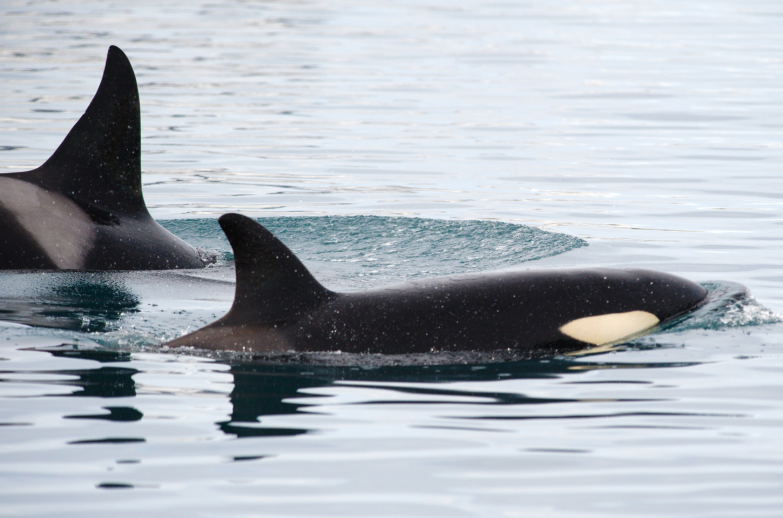Powerful, intelligent, and awe-inspiring, killer whales — also known as orcas — are some of the most iconic marine mammals in the world. In Southeast Alaska, they are more than just a thrilling sight. Killer whales in Ketchikan are a vital part of the region’s ecosystem, culture, and connection to the sea.
Spotting the tall dorsal fin of an orca slicing through the water or hearing the haunting call of a nearby pod is more than wildlife viewing — it’s a deeply moving encounter with the wild. In this guide, we’ll explore the fascinating world of killer whales in Ketchikan: their behavior, biology, cultural significance, and why seeing them on your Alaska adventure is an experience you won’t forget.
Quick Facts About Killer Whales
Despite their name, killer whales (Orcinus orca) are actually the largest members of the dolphin family. These marine mammals are top predators, known for their bold black-and-white markings, social intelligence, and complex hunting strategies.
You’ll often spot killer whales in Ketchikan traveling in tight-knit groups called pods. They swim through the Inside Passage, hunting, playing, and moving gracefully through the same waters our tours explore every day.
Scientific Name: Orcinus orca
Also Called: Killer whales, orcas
Size:
Males: 20–26 feet long and up to 12,000 pounds
Females: 16–23 feet, slightly smaller
Intelligence:
Orcas use vocal calls, pass down learned hunting techniques, and show tight family bonds. Some scientists even refer to their pods as having “culture.
Diet in Southeast Alaska:
Resident orcas focus on fish like salmon
Transient (Bigg’s) orcas hunt marine mammals such as seals and porpoises
Behavior:
Highly social and vocal, they form raucous colonies on rocky islands and beaches, especially during breeding season. Males establish harems of females, fiercely defending their territory with loud roars and physical posturing.
Where to Spot Them:
Killer whales in Ketchikan are commonly seen during salmon runs. Look for dorsal fins, surface splashes, and water sprays. You might even hear their distinct exhale across the water.

Why Killer Whales Matter for Ketchikan's Ecosystem
As apex predators, killer whales in Ketchikan help maintain balance in the marine ecosystem. They control populations of seals, sea lions, and fish, which supports ocean health.
They also act as environmental indicators. If their behavior or numbers shift, it could reflect broader issues like overfishing, pollution, or climate-related changes in the sea.
Indigenous Connection to Killer Whales
To Alaska Native communities such as the Tlingit, Haida, and Tsimshian, killer whales in Ketchikan are sacred beings. Known as Keet in the Tlingit language, orcas appear in stories, clan crests, and totem poles as protectors and spiritual guides.
Cultural Significance:
Totemic Role: Clans like Keet Gooshi Hit (Killer Whale Dorsal Fin House) feature the orca as a central symbol.
Family & Unity: Orca behavior mirrors community values — strong bonds, loyalty, and protection.
Oral Traditions: Some stories tell of people becoming orcas or orcas rescuing those lost at sea. The ocean is their home, and they are respected as relatives.
This connection lives on today, as orcas remain honored across the coastal Native communities of Alaska.

Threats to Killer Whales in Ketchikan
Although killer whales are apex predators, they are not immune to threats. Environmental challenges impact populations across the Pacific, and killer whales in Ketchikan face similar pressures.
Major Threats:
Toxins and Pollution: Orcas absorb contaminants through their food chain
Noise Pollution: Vessel traffic can interrupt hunting and navigation
Overfishing: Fewer salmon means less food for resident orcas
Climate Change: Alters ocean temperatures and prey availability
Conservation in Action:
Thankfully, orcas are protected under the Marine Mammal Protection Act and, in some regions, the Endangered Species Act. Organizations like NOAA monitor populations, study health patterns, and promote responsible marine practices.
Our own wildlife tours help by educating visitors about killer whales in Ketchikan and encouraging safe, respectful viewing that puts marine life first.
Fun Facts About Killer Whales
Orcas can live up to 90 years, often in matriarch-led pods
Each pod has its own unique vocal dialect
They hunt cooperatively — some even knock seals off ice floes
A male orca’s dorsal fin can grow over 6 feet tall
No wild killer whale has ever harmed a human
Why You Should See Killer Whales in Ketchikan
Watching killer whales glide through Alaska’s coastal waters is unforgettable. Whether you’re a first-time visitor or a seasoned wildlife watcher, seeing killer whales in Ketchikan is something that sticks with you forever.
Our guided tours give you the chance to witness these majestic animals up close — safely, respectfully, and in their natural element. Furthermore, you’ll also have the opportunity to spot sea lions, eagles, harbor seals, and more.
Book a Wildlife Tour to See Killer Whales in Ketchikan
Ready to meet Alaska’s most intelligent and awe-inspiring marine mammals?
Book one of our Ketchikan Wildlife Tours and get the chance to witness killer whales in Ketchikan — along with the stunning natural beauty of Southeast Alaska. These are the kinds of moments you’ll tell stories about for years.

